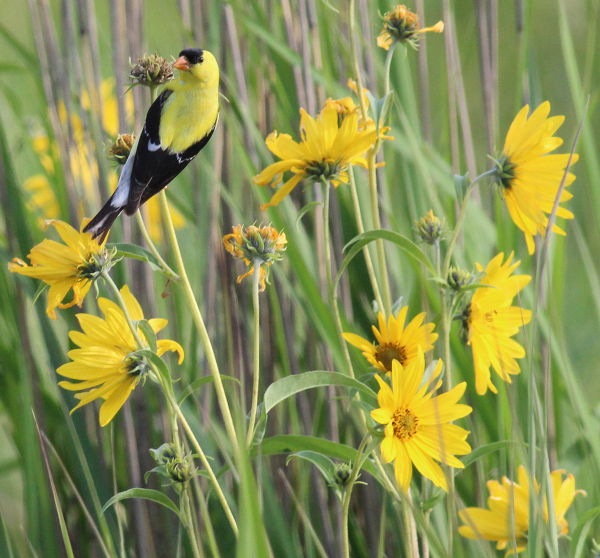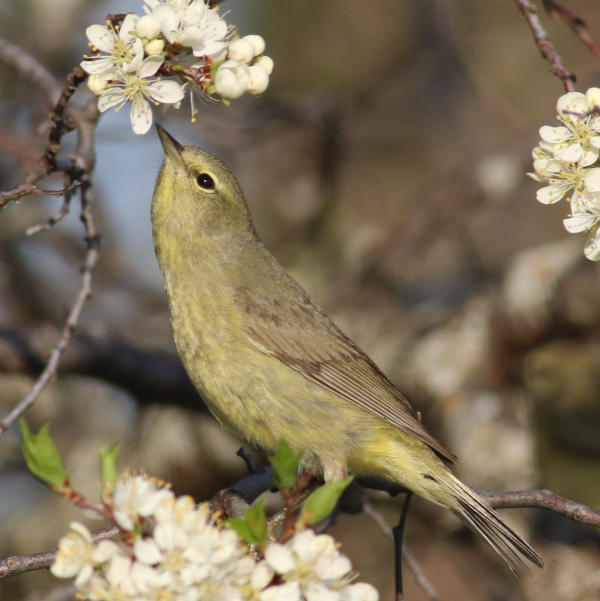
Wild coneflowers and sunflowers are among a wide variety of native plants that will add color to your yard and attract colorful birds, like this American Goldfinch (photos by Paul Konrad).

Reaching for a tiny insect among wild plum blooms, this Orange-crowned Warbler is one of many species that benefit from native plants in our yards during spring, and fall.
|
As you think about how you can improve your yard for birds this fall, consider adding or expanding areas of native plants, including native flower beds, as a replacement for a weedy area, or as a border to shrubs, trees, rocks, or other landscaping elements. Actually, native shrubs and trees are always an excellent choice too. Why? Because they grow and thrive better in their natural range, and birds and other animals have adapted to the qualities of native plants’ leaves, flowers, berries, fruits, and seeds. Native birds do best where native plants are available.
Fall is a great time to collect seeds from native plants that you find attractive and would like to add to your yard and, of course, it’s also important to consider what birds they will attract. Even if you wait to plant some natives during the spring season, you will want to collect some seeds this fall from area fields and wooded areas where you have access.
Many birders find native plants to be more attractive than an expansive area of mowed lawn that requires maintenance and mowing, and more water. Some birders have broken up the monotony of a traditional lawnscape by carving out areas for native plants, thereby adding attractive “islands” of native plantings – a real plus for their overall landscaping.
Native plants are adapted to your area, including the soil, annual rainfall, the range of temperatures, and other weather conditions that allow them to withstand variations in precipitation and other aspects of weather or climate.
Consider adding a mix of annual and perennial plants; your plantings will be more attractive if they include a diversity of different native plants.
Local conditions will vary, so it’s hard to suggest specific plants and trees for our broad readership, so it will be up to you to do a little research by checking in with local greenhouses, horticulturists, arborists, and native landscaping companies. And that’s a fun part of the process.
Introduced, or non-native, plants that are relatively new to an ecosystem do not always have the same characteristics that make them compatible with the native fauna. As a result, insects and some other wildlife are unable to eat or reproduce on introduced plants with the same success.
In addition to the other bird foods listed above, keep in mind that native plants provide fodder for local insects including caterpillars, and spiders that feed a wide variety of birds in season, especially neotropical migrant songbirds passing through during September. Don’t worry about being overpowered by more insects, the bugs we’re talking about tend to be tiny and mostly unseen – except by little warblers, vireos, and other migrating songbirds.
A Healthy Food Web
Consider even a single tree, and all the bugs – insects, spiders, caterpillars, and more – that are hidden among the leaves and branches and bark, flowers and seeds. Decades of studies show that local insects have evolved to eat vegetation and other products created by native plants they have shared an evolutionary history with, and birds have shared that same evolutionary history with the plants and bugs.
In any healthy food web, where you find a diversity of insects, you will also find the species that feed upon them, especially birds. Without native plants as the primary food source, diversity in such a food web can be drastically reduced. Studies show that in the same locations, introduced plants show reduced biodiversity and biomass at both the herbivorous and insectivorous levels.
A study conducted by the University of Delaware’s Department of Entomology and Wildlife Ecology on 6 pairs of suburban properties in southeast Pennsylvania showed that yards with native landscaping not only attracted 8 times as many birds, they also attracted a greater diversity of bird species compared to properties with non-native plant species.
The researchers speculated the birds were attracted to the increased number and diversity of caterpillars, which was 4 times greater at the native plant sites. This study gives hope that even in densely populated areas, such as suburbs and cities, adding areas of native plantings, or switching to native landscaping can have a positive impact to benefit birds and other native animals, and on grand scale it could benefit the conservation and biodiversity of birds in impressive ways.
The value of adding a native plant section to your yard, a scattering of native shrubs, and a native tree or more, can provide valued new elements for you to appreciate, along with increased numbers and diversity of birds that visit your property. Enjoy your fall season this first day of fall 2021.
Share your backyard birding experiences and photos at editorstbw2@gmail.com